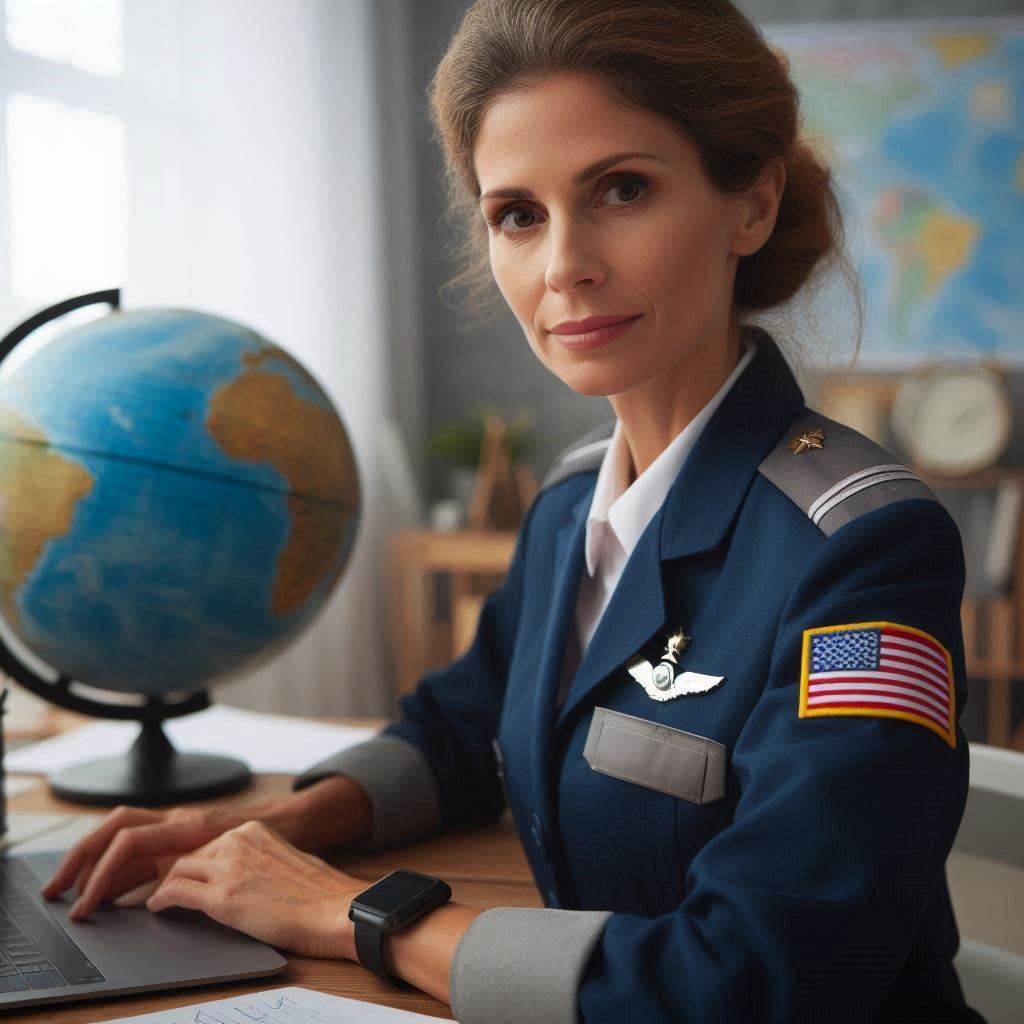Introduction
Drone technology refers to the development and operation of unmanned aerial vehicles (UAVs) that can fly autonomously.
Drones have become increasingly popular in various industries, including agriculture, cinematography, and surveillance.
Aerospace engineers play a crucial role in designing, testing, and improving drone technology to enhance its capabilities and performance.
The Role of Aerospace Engineers in Developing Drone Technology:
Aerospace engineers are responsible for designing the structural components of drones, ensuring they are lightweight yet durable.
They also design the propulsion systems that enable drones to fly efficiently and maneuver through different environments.
Additionally, aerospace engineers work on the software and control systems of drones, allowing operators to control and monitor drones remotely.
They also incorporate sensors and cameras into drones for navigation and data collection purposes.
Furthermore, aerospace engineers conduct tests and simulations to optimize the flight characteristics of drones, such as speed, stability, and endurance.
They analyze the data gathered from these tests to make necessary adjustments and improvements to enhance the overall performance of drones.
Moreover, aerospace engineers are involved in research and development to introduce advancements in drone technology.
Increasing flight range, improving battery life, and enhancing communication systems.
They collaborate with other professionals, such as software engineers and data analysts, to integrate new technologies into drone systems.
Most Importantly, aerospace engineers play a vital role in the innovation and advancement of drone technology.
Their expertise and knowledge contribute to the development of safer, more efficient. versatile drones that have a wide range of applications in various industries.
Understanding Drone Technology
Drone technology is a rapidly evolving field that has gained significant popularity in recent years.
Drones, also known as unmanned aerial vehicles (UAVs), are aircraft without a human pilot on board.
They can be remotely controlled or operate autonomously through pre-programmed flight plans.
Explanation of How Drones Work
Drones, also known as unmanned aerial vehicles (UAVs), operate using remote control or autonomous systems.
Aerospace engineers design drones to achieve stability, control, and efficient flight.
Drones typically use a combination of rotors, wings, and propulsion systems to navigate.
The core of a drone’s functionality lies in its control systems.
These systems include onboard computers that process data from sensors and control the drone’s movements.
Aerospace engineers develop algorithms that ensure the drone maintains stability and responds accurately to commands.
Drones use GPS and other navigation systems to determine their position and navigate to specific locations.
Engineers design these systems to integrate with the drone’s control mechanisms, allowing for precise and reliable flight.
Overview of the Various Components of a Drone
A drone consists of several key components, each playing a crucial role in its operation.
The airframe provides the structure and supports the other components.
It is designed for lightweight and aerodynamic efficiency, enabling smooth flight and maneuverability.
Propulsion systems, including motors and propellers, generate thrust and lift.
Aerospace engineers optimize these systems for power efficiency and performance, considering factors like weight and balance.
The control system includes the flight controller, sensors, and communication devices.
The flight controller acts as the drone’s brain, processing inputs from sensors and commands from the operator.
Sensors, such as gyroscopes and accelerometers, provide data on the drone’s orientation and movement.
The power supply, typically a battery, powers the drone’s systems and propulsion.
Engineers focus on developing batteries that provide long flight times and quick recharging capabilities.
Importance of Drones in Different Sectors
Drones have become vital in various sectors, revolutionizing industries and enhancing capabilities.
In agriculture, drones assist in crop monitoring, providing real-time data on plant health and soil conditions.
They enable precision agriculture, where farmers can optimize water and fertilizer use, increasing yield and sustainability.
In surveillance and security, drones offer a cost-effective solution for monitoring large areas.
Law enforcement and emergency responders use drones for search and rescue operations, traffic monitoring, and crime scene analysis.
Aerospace engineers design drones with advanced cameras and sensors to capture high-resolution images and videos.
Drones are also transforming the delivery services sector.
Companies use drones to deliver packages quickly and efficiently, especially in remote or congested areas.
Engineers design delivery drones to carry payloads securely and navigate complex environments.
Drones play a crucial role in scientific research, environmental monitoring, and infrastructure inspection.
They provide access to hard-to-reach areas, enabling detailed data collection and analysis.
Aerospace engineers play a vital role in the development and operation of drones.
They design and optimize key components such as control systems, propulsion, and airframes, ensuring efficient and reliable performance.
Drones are revolutionizing various sectors, including agriculture, surveillance, and delivery services, providing new capabilities and efficiencies.
Firstly In agriculture, drones enable precision farming, enhancing crop monitoring and resource management.
In surveillance, drones offer effective solutions for monitoring and emergency response.
In delivery services, drones facilitate rapid and efficient package delivery.
As drone technology advances, aerospace engineers continue to innovate, expanding the applications and capabilities of drones.
Their work ensures that drones remain an integral tool in various industries, driving progress and innovation in the modern world.
Responsibilities of Aerospace Engineers
Designing and Building Drones from Scratch
Aerospace engineers play a critical role in designing and building drones from scratch.
They start by conceptualizing the drone’s structure, considering factors like aerodynamics, weight, and material strength.
Using specialized software, they create detailed designs that outline the drone’s components, including the frame, propulsion system, and onboard electronics.
Transform Your Career Today
Unlock a personalized career strategy that drives real results. Get tailored advice and a roadmap designed just for you.
Start NowThese engineers are responsible for selecting the right materials that balance durability and weight.
They work on integrating propulsion systems, such as electric motors and propellers, ensuring that the drone can achieve desired speeds and maneuverability.
The design process also involves planning for payload capacity, which dictates how much the drone can carry, such as cameras or sensors.
Aerospace engineers focus on the power system, including batteries and energy efficiency.
They design the control systems that enable stable flight and precise movements.
This involves programming the drone’s onboard computer to manage flight dynamics and respond to pilot commands.
Testing and Troubleshooting Drone Prototypes
Once a drone is built, aerospace engineers conduct rigorous testing to ensure it meets performance standards.
They test drones in controlled environments, such as wind tunnels, to assess aerodynamic properties.
These tests help engineers understand how the drone behaves under different conditions, like high winds or varying altitudes.
Field testing is crucial for evaluating the drone’s real-world capabilities.
Engineers observe how the drone handles takeoff, flight, and landing.
They collect data on flight stability, control responsiveness, and energy consumption.
This data is essential for identifying any design flaws or areas for improvement.
Troubleshooting is a key part of the testing process.
Engineers diagnose issues that arise during testing, such as unexpected vibrations or communication failures.
They then make necessary adjustments, whether it‘s redesigning a component or reprogramming control software.
This iterative process ensures that the final product is reliable and performs as expected.
Collaborating with Other Professionals to Enhance Drone Technology
Aerospace engineers often collaborate with other professionals to enhance drone technology.
They work closely with electrical engineers to integrate sensors and communication systems into the drone’s design.
This collaboration ensures that the drone can gather and transmit data effectively.
Working with software developers, aerospace engineers develop sophisticated algorithms for navigation and autonomous flight.
These algorithms enable drones to perform complex tasks, such as obstacle avoidance and precise landings.
Collaboration with data scientists allows for the processing and analysis of data collected by drones.
Enhancing their applications in fields like agriculture and surveillance.
Engineers also collaborate with regulatory experts to ensure that drones comply with aviation laws and safety standards.
This is crucial for commercial drones, which must meet specific criteria to operate legally in various airspaces.
Aerospace engineers are at the forefront of drone technology, playing a vital role in designing, building, and refining drones.
Their expertise ensures that drones are not only functional and efficient but also safe and reliable.
Through collaboration with other professionals, aerospace engineers continue to push the boundaries of what drones can achieve.
Contributing to advancements in various industries and applications.
This ongoing innovation makes drones increasingly integral to fields like logistics, agriculture, and environmental monitoring.
Read: How US Architects Adapt to Climate Change Concerns
Skills Required for Aerospace Engineers
Strong Knowledge of Aerodynamics and Flight Mechanics
Aerospace engineers play a critical role in the development of drone technology, primarily due to their strong knowledge of aerodynamics and flight mechanics.
This expertise is essential for designing drones that are stable, efficient, and capable of precise movements.
Aerodynamics involves studying how air interacts with solid objects, which is crucial in optimizing drone shapes for better lift and reduced drag.
Understanding flight mechanics helps aerospace engineers design control systems that ensure drones can maneuver safely and efficiently.
They analyze factors such as weight distribution, thrust, and stability to create drones that can perform specific tasks, from simple surveillance to complex deliveries.
This foundation in aerodynamics and flight mechanics is the cornerstone of creating drones that can operate reliably in various conditions.
Proficiency in Software and Programming Languages for Drone Control Systems
In addition to traditional engineering skills, aerospace engineers must be proficient in software and programming languages used in drone control systems.
Modern drones rely heavily on sophisticated software for navigation, communication, and automation.
Engineers need to develop and implement algorithms that control drone behavior, including flight paths, obstacle avoidance, and mission execution.
Programming languages such as C++, Python, and MATLAB are commonly used in developing these control systems.
Aerospace engineers use these languages to write code that integrates with hardware components, ensuring seamless operation.
They also work on developing user interfaces and communication protocols that allow drones to interact with other systems, such as GPS satellites or ground control stations.
This proficiency in software and programming is essential for building drones that can operate autonomously or be remotely controlled with high precision.
It also enables engineers to create adaptable systems that can be updated or modified as technology advances.
Ability to Analyze Data and Make Improvements to Drone Designs
A critical aspect of an aerospace engineer’s role in drone technology is the ability to analyze data and make improvements to drone designs.
Data analysis is crucial for evaluating drone performance, identifying areas for improvement, and ensuring safety and efficiency.
Engineers collect data from test flights, simulations, and real-world operations to understand how drones perform under different conditions.
They analyze this data to identify patterns, diagnose issues, and optimize designs.
For instance, data might reveal a need for better battery efficiency, improved aerodynamics, or more robust navigation systems.
Engineers use these insights to refine designs, making drones more reliable and capable of handling more complex tasks.
The ability to iterate on drone designs based on data analysis is vital for keeping up with technological advancements and industry demands.
It ensures that drones continue to evolve, becoming more efficient, versatile, and safer for various applications.
Aerospace engineers are integral to the advancement of drone technology.
Their strong knowledge of aerodynamics and flight mechanics lays the foundation for designing efficient and stable drones.
Proficiency in software and programming languages is essential for developing sophisticated control systems that enable precise and autonomous operations.
Additionally, their ability to analyze data and refine designs ensures continuous improvement in drone technology.
As the demand for drones grows in various industries, from agriculture to delivery services, the role of aerospace engineers becomes increasingly important.
They are at the forefront of innovation, driving the development of drones that are more capable, efficient, and adaptable to a wide range of applications.
This blend of technical skills and innovative thinking positions aerospace engineers as key contributors to the future of drone technology.
Read: Diversity in the US Architectural Scene: A Deep Dive
Challenges Faced by Aerospace Engineers in Drone Technology
Aerospace engineers play a crucial role in the development and advancement of drone technology.
However, they face several challenges in ensuring that drones operate safely, efficiently, and reliably.
Meeting Regulatory Requirements
One of the main challenges for aerospace engineers working on drone technology is ensuring that their designs and operations comply with strict regulatory requirements.
These regulations are put in place to ensure public safety and prevent accidents or misuse of drones.
Engineers must stay up-to-date with changing regulations and adapt their designs accordingly to meet these requirements.
Ensuring Safety and Security Measures
Another significant challenge for aerospace engineers is ensuring that safety and security measures are adequately implemented in drone technology.
Safety measures include features like collision avoidance systems, emergency landing capabilities, and fail-safe mechanisms.
Security measures involve encrypting communication signals, preventing unauthorized access, and safeguarding against cyber attacks.
Engineers must constantly assess and improve these measures to mitigate risks and protect against potential threats.
Addressing Technical Issues
Technical issues related to drone performance and reliability present ongoing challenges for aerospace engineers.
These issues can range from optimizing power systems and improving flight controls to enhancing payload capacity and increasing flight endurance.
Engineers must troubleshoot these technical challenges, conduct rigorous testing.
Iterate on designs to ensure drones operate efficiently and reliably in various conditions.
In general, aerospace engineers face complex challenges in developing drone technology.
Including meeting regulatory requirements, ensuring safety and security measures, and addressing technical issues.
By overcoming these challenges, engineers can continue to drive innovation and advancement in the field of drone technology.
Read: Freelance vs. Firm: Career Paths for US Architects
Discover More: Quality Control Inspector: Roles and Responsibilities
Advancements in Drone Technology
Recent developments in drone technology have revolutionized the industry, making significant strides in autonomous flight capabilities.
Drones can now navigate complex environments on their own, thanks to advanced sensors and AI algorithms.
Showcase Your Business Today
Reach thousands of readers actively exploring professional services. Publish your business profile and grow your audience now.
Publish NowAerospace engineers play a crucial role in developing autonomous drones by designing cutting-edge control systems that enable precise navigation and obstacle avoidance.
These engineers are constantly pushing the boundaries of technology to enhance the efficiency and safety of drone operations.
Recent Developments
- Autonomous Flight Capabilities: Drones can now fly without human intervention, making them suitable for various applications.
- Enhanced Sensors: Advanced sensors enable drones to perceive their surroundings accurately and make real-time decisions.
- AI Algorithms: Artificial intelligence algorithms help drones analyze data and adapt to changing conditions during flight.
Potential Future Applications
- Delivery Services: Drones could revolutionize delivery services by offering fast and efficient package delivery to remote areas.
- Surveillance and Security: Drones equipped with high-resolution cameras could enhance surveillance and security operations.
- Disaster Response: Drones can be used to assess disaster-affected areas quickly and efficiently, aiding in rescue and relief efforts.
Role of Aerospace Engineers
Aerospace engineers are at the forefront of drone technology, driving innovation and pushing the boundaries of what is possible.
These engineers leverage their expertise in aerodynamics, propulsion, and control systems to enhance drone performance and capabilities.
By designing efficient propulsion systems, aerospace engineers can extend the flight time of drones, enabling longer missions and applications.
They also optimize drone designs to maximize payload capacity and endurance while minimizing energy consumption.
Moreover, aerospace engineers develop sophisticated control algorithms that govern the behavior of drones during flight, ensuring stability, precision, and safety.
These algorithms are essential for autonomous drones to navigate complex environments and perform tasks with accuracy.
Additionally, aerospace engineers work on integrating emerging technologies.
As machine learning and computer vision, into drone systems to enhance their capabilities further.
By leveraging these technologies, drones can perform more advanced tasks and adapt to dynamic environments effectively.
Therefore, aerospace engineers play a pivotal role in advancing drone technology and shaping its future applications.
Their expertise and dedication drive innovation in the field, ensuring that drones continue to evolve and revolutionize various industries.
Read: Iconic US Buildings and the Architects Behind Them.

Learn More: Essential Skills for Geotechnical Engineers
Gain More Insights: Mining Engineer vs. Geological Engineer: Key Differences
Impact of Aerospace Engineers on Drone Technology
Underneath the sleek appearance of drones lies the hard work and expertise of aerospace engineers.
Let’s delve into the impact of aerospace engineers on drone technology.
Their contributions to its evolution, and how they are shaping the future of drones.
The Contributions of Aerospace Engineers to the Evolution of Drone Technology
Aerospace engineers have been instrumental in the evolution of drone technology.
Their expertise in aerodynamics, propulsion systems, and control technologies has driven significant advancements in drone design and capabilities.
From the earliest models to today’s sophisticated systems, aerospace engineers have consistently improved the performance, reliability, and versatility of drones.
Aerospace engineers have developed lightweight materials and innovative airframe designs, enhancing drones’ maneuverability and endurance.
They have also created advanced propulsion systems that increase efficiency and extend flight times.
These improvements have broadened the applications of drones across various industries.
In addition to hardware advancements, aerospace engineers have made significant contributions to drone control systems.
They have developed complex algorithms and software that allow drones to navigate autonomously and respond to environmental changes.
This has led to the integration of drones into more complex and critical tasks.
How Aerospace Engineers Are Shaping the Future of Drones
Looking to the future, aerospace engineers are shaping the next generation of drones.
They are working on enhancing autonomy, enabling drones to operate with minimal human intervention.
This involves developing advanced artificial intelligence (AI) and machine learning algorithms that allow drones to learn from their environments and make real-time decisions.
Engineers are also exploring new propulsion technologies, such as electric and hybrid systems, to make drones more environmentally friendly.
These innovations aim to reduce the carbon footprint of drone operations, aligning with broader goals of sustainability.
Aerospace engineers are pushing the boundaries of drone applications, exploring areas like urban air mobility and disaster response.
They are designing drones capable of carrying larger payloads and operating in challenging environments.
These advancements could revolutionize logistics, emergency services, and environmental monitoring.
The integration of drones with other technologies, such as the Internet of Things (IoT) and 5G networks, is another area of focus.
Aerospace engineers are working on systems that allow drones to communicate and coordinate with other devices.
Creating new possibilities for automation and data collection.
Importance of Their Role in Advancing Drone Technology
The role of aerospace engineers in advancing drone technology is crucial.
Their expertise ensures that drones are safe, reliable, and capable of performing complex tasks.
They address challenges related to flight stability, energy efficiency, and regulatory compliance, which are essential for the widespread adoption of drones.
Aerospace engineers also play a vital role in addressing ethical and privacy concerns associated with drone use.
They design systems that protect data and ensure that drones are used responsibly.
This is particularly important as drones become more integrated into public and private spaces.
The work of aerospace engineers directly impacts the economic and technological landscape.
By advancing drone technology, they contribute to the growth of industries, create new job opportunities.
Enhance the quality of services in sectors such as healthcare, agriculture, and logistics.
Aerospace engineers have been at the forefront of the evolution of drone technology, driving innovations in design, control systems, and applications.
Their contributions have significantly expanded the capabilities and reliability of drones, making them indispensable tools in various industries.
Looking ahead, aerospace engineers are shaping the future of drones through advancements in autonomy, and integration with emerging technologies.
They are exploring new frontiers in urban mobility, environmental monitoring, and emergency response.
The importance of aerospace engineers in advancing drone technology cannot be overstated.
Their work ensures that drones are not only technologically advanced but also safe, ethical, and sustainable.
As the demand for drone technology continues to grow, the role of aerospace engineers will remain crucial in unlocking the full potential of this transformative field.
Conclusion
Aerospace engineers play a crucial role in the advancement of drone technology.
They are responsible for designing, testing, and improving the performance of drones.
Their expertise in aerodynamics, propulsion systems, and materials science is vital in creating drones that are efficient, reliable, and safe.
Throughout this blog post, we have highlighted how aerospace engineers contribute to the development of drone technology.
From designing the structure of drones to optimizing their flight characteristics, aerospace engineers are at the forefront of innovation in this field.
It is essential to recognize the significance of aerospace engineers in shaping the future of drone technology.
Their knowledge and skills drive progress in the industry, leading to new capabilities and applications for drones in various sectors.
We encourage our readers to explore the exciting field of drone technology and consider the role of aerospace engineers in this dynamic industry.
The opportunities for innovation and growth are endless, and by understanding the contributions of aerospace engineers.
individuals can appreciate the impact they have on shaping the future of drone technology.
[E-Books for Sale]
The Big Book of 500 High-Paying Jobs in America: Unlock Your Earning Potential
$19.99 • 500 High-Paying Jobs • 330 pages
Explore 500 high-paying jobs in America and learn how to boost your career, earn more, and achieve success!
See All 500 High-Paying Jobs of this E-Book
1001 Professions Without a Degree: High-Paying American Jobs You Can Start Now
$19.99 • 1001 Professions Without a Degree • 174 pages
Discover 1001 high-paying jobs without a degree! Unlock career tips, skills, and success strategies for just $19.99!




